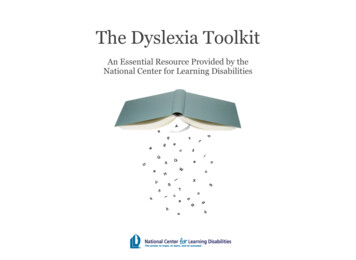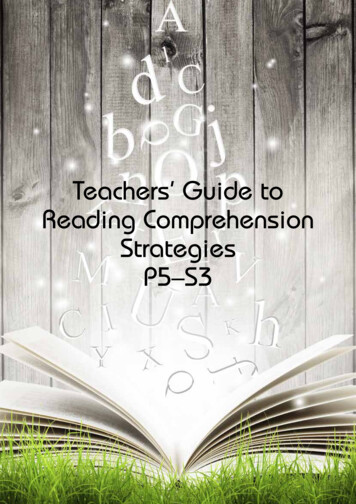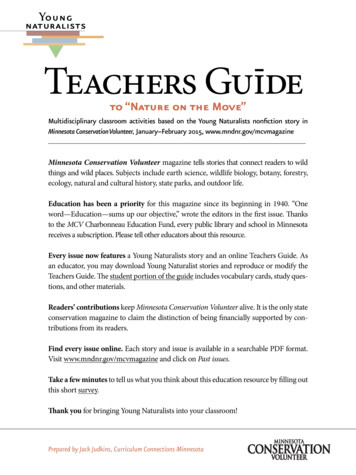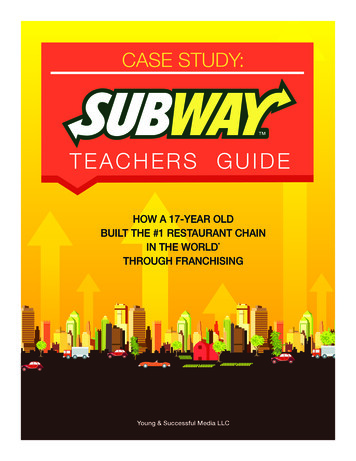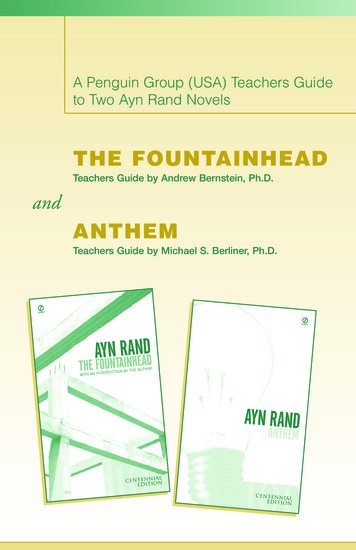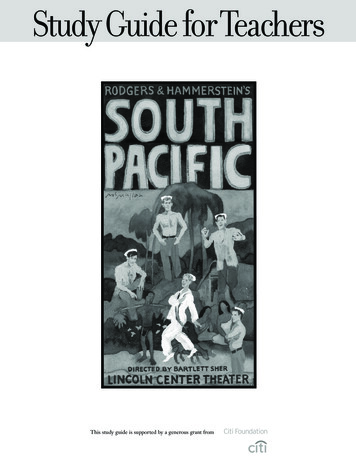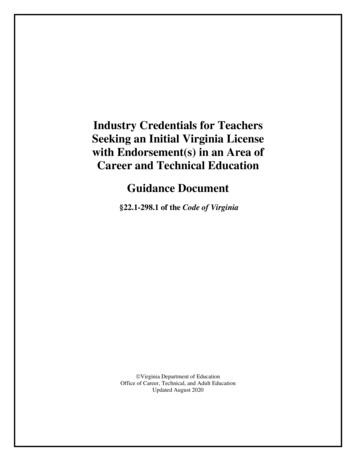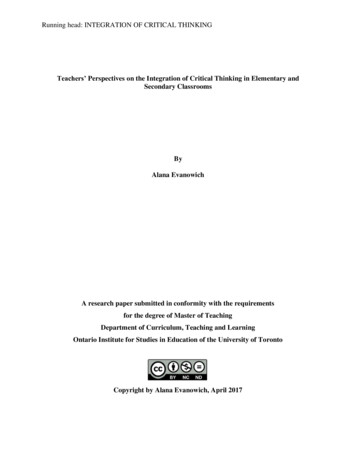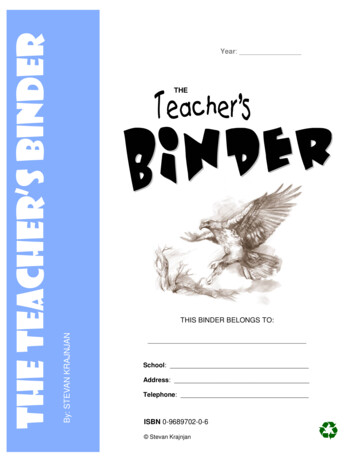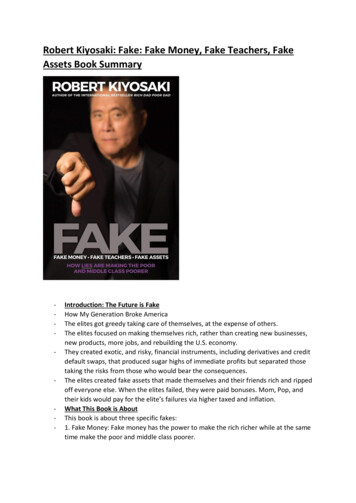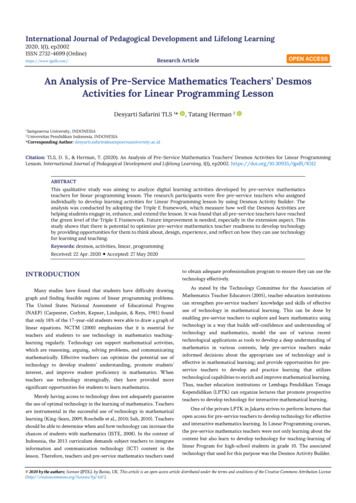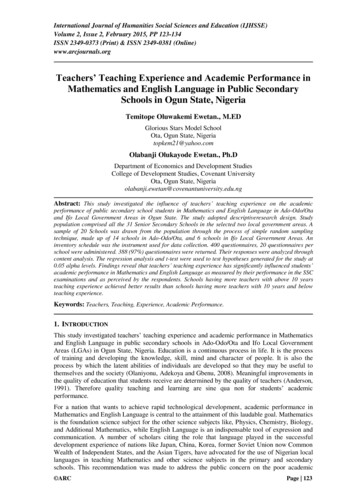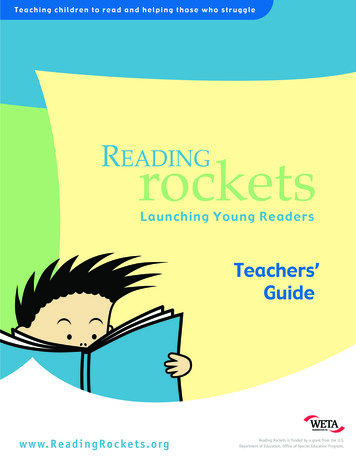
Transcription
Teaching children to read and helping those who struggleLaunching Young ReadersTeachers’Guidew w w. R e a d i n g R o c ke t s. o rgReading Rockets is funded by a grant from the U.S.Department of Education, Office of Special Education Programs.
MESSAGE FROM THE DIRECTORDear Educator,If reading came naturally, teaching would be a much easier job. Children would learn toread as readily as they learn to speak. Teachers would only need to give students thechance to practice their skills.But children don’t learn to read just from being exposed to books. Reading must betaught. For many children, reading must be taught explicitly and systematically, onesmall step at a time.Researchers have made a lot of progress in determining how to teach reading moreeffectively. For teachers, the challenge is how to use that research to address the needsof your students . especially children who struggle. That’s what Launching YoungReaders is all about.In producing our PBS series and this guide, our goal was to bring the reading research tolife — and to present it in a way that teachers would find most helpful. This guideincludes some research-based principles for teaching reading, a glossary of reading terms,and a list of resources.Launching Young Readers is part of Reading Rockets, a multimedia project that alsoincludes a one-hour documentary, extensive outreach, and a series of teleconferences foreducators. We also have a comprehensive Web site, www.ReadingRockets.org, withdetailed information about teaching reading and helping children who fall behind.Please visit us on the Web and let us know what you think.We hope you enjoy the series and this guide. Best wishes on launching successful youngreaders in your classroom!Cordially,Noel GuntherExecutive Director, Reading Rockets
Babies are born with the instinct to speak,the way spiders are born with the instinct to spinwebs. You don’t need to train babies to speak;they just do. But reading is different.—S t e v e nP i n k e r ,M I TWRITTEN BY READING ROCKETS ADVISOR DR. LOUISE SPEAR-SWERLINGReading Rockets is a service of WETA, Washington, D.C.’s flagship public television station, withfunding provided by the U.S. Department of Education, Office of Special Education Programs.This guide was created by WETA, which is solely responsible for its content.Reading Rockets: Launching Young Readers is a co-production of WETA and Rubin Tarrant Productions. 2002, Greater Washington Educational Telecommunications Association, Inc.
CONTENTSIntroduction5About the Television SeriesReading Achievement66778899Why Is Early Reading Achievement So Important?Learning to Read and WriteThe Nature of Written EnglishWhy Some Children Learn to Read Easily While Others StruggleThe Role of MotivationChildren Who Are at Risk for Reading DifficultiesReading Risk Indicators by Grade LevelHow to Help an At-Risk ChildStrategies for Teaching Reading1013161923Program 1: The Roots of ReadingProgram 2: Sounds and SymbolsProgram 3: Fluent ReadingProgram 4: Writing and SpellingProgram 5: Reading for MeaningResources and References2728293031Videos and GuidesReading Rockets Web SitesGlossaryBooks and ReferencesAcknowledgments
Many things we need can wait. The child cannot.Now is the time his bones are formed, his minddeveloped. To him we cannot say tomorrow,his name is today.—C h i l e a np o e tG a b r i e l aM i s t r a l
INTRODUCTIONAbout the Television SeriesReading Rockets: Launching Young Readers is a public TV series designed for teachers, parents,caregivers, and anyone else interested in helping children learn to read. Based on the latestresearch findings, the series consists of five 30-minute programs that explore the stages of readingthat every child goes through. It features the country’s top reading experts and model classrooms.Each program presents six or seven closely linked stories,Program 4: Writing and Spelling offers successful meth-illustrating the distinct stages of how children learn to readods that encourage children to write, build vocabulary, andand how adults can help them. Hosted by popular per-develop spelling skills. Hosted by actress Vivica A. Fox andsonalities such as Fred Rogers, the programs each featurefeaturing children’s book author Kate Duke (Aunt Isabela short segment on a prominent children’s book author.Tells a Good One).Program 1: The Roots of Reading looks at the earliestProgram 5: Reading for Meaning presents effectivestages of literacy and offers practical advice for parents,strategies to help children understand and care aboutchild care providers, and kindergarten teachers. Hosted bywhat they read. Hosted by teacher and author Frankchildren’s television personality Fred Rogers and featuringMcCourt (Angela’s Ashes) and featuring award-winningchildren’s book author and illustrator Rosemary Wellschildren’s book author Walter Dean Myers (Harlem).(Timothy Goes to School).The Reading Rockets: Launching Young ReadersProgram 2: Sounds and Symbols focuses on two criticaltelevision series is available for purchase in eitherskills that early readers need for decoding the printed word:VHS or DVD-ROM format. For information, log on tophonemic awareness and phonics. Hosted by actresswww.ReadingRockets.org or call 800-228-4630. AdditionalAnnette Bening and featuring Norman Bridwell, creatorcopies of this guide can be downloaded free of chargeof Clifford the Big Red Dog.at www.ReadingRockets.org.Program 3: Fluent Reading highlights successful strategiesfor helping children become fluent readers and shows howearly testing and intervention can help struggling readers.Hosted by television personalities Deborah Norville and Theofrom Between the Lions and featuring celebrated children’sauthor William Joyce (George Shrinks).T E A C H E R S ’G U I D E 5
READING ACHIEVEMENTWhy Is Early ReadingAchievement So Important?Learning to Read and WriteReading achievement is central to success in school.Reading, by contrast, is not “natural.” The process ofDifficulty in reading soon affects almost every aspect of alearning to read is far different from the process ofchild’s academic performance. It is important, therefore,learning to speak.Speaking a language comes naturally to most children.to identify and address problems with reading as soon aspossible. Studies have shown that most struggling readersCurrent research indicates that language abilities (thewho are identified early and taught appropriately can learnability to speak and understand a language) and notto read on grade level. That is one of the most promisingvisual perceptual abilities (the ability to visually distin-findings of recent reading research.guish between objects, such as the letters in words)serve as the essential foundation of reading and writing.Without early identification and intervention, children whoConsequently, children who lack oral language competencestruggle during these early grades typically continue to havein English are at increased risk for difficulty in learning toreading problems. In the absence of an effective interven-read and write.tion, these students tend to fall farther behind their peerswith each passing year as the demands of the curriculumMuch of this guide will focus on the specific abilities that arebecome more intense. Poor readers are also at increased riskimportant to achievement in reading and writing, such as:for many other problems, such as: Phonemic awareness (sensitivity to the speech Emotional and behavioral problems Substance abuse Dropping out of school Poverty and low achievement as adultsAlthough older children and adults often benefit fromintervention, reading problems become harder toremediate with age.6 W W W . R E A D I N G R O C K E T S . O R Gsounds in spoken words) Vocabulary knowledge The ability to read individual words accurately andrapidlyReading and writing are interrelated, but for clarity andease of discussion they are dealt with separately in thisguide and in the television series.
The Nature of Written EnglishBecause English is an alphabetic language — that is, theletters used in writing generally relate to sounds in spokenEnglish words — beginning readers need a high degree ofsensitivity to individual sounds in words. This sensitivity isnot an easy or automatic achievement for many children.Instruction in spelling-sound relationships and phonics isindispensable for beginning readers and spellers, but to beeffective beyond the earliest stages of learning to read,instruction must also incorporate the teaching of commonletter patterns and morphemic relationships.The English alphabetic system is relatively complex. ManyWhy Some Children Learn to ReadEasily While Others StruggleEnglish letters can have more than one sound (e.g., the let-There are many factors contributing to a child’s success inter “a” sounds different in “cat,” “cave,” “ball,” and “dark”).reading. Learning to read comes more easily to some chil-To decode unfamiliar words, a reader must pay attention todren than to others, just as children differ in how easilyletter patterns as well as the individual letters. For instance,they learn mathematics, play sports, or master a musicalit is easier for beginning readers to decode the word “dark”instrument. Children are individuals who have differentif they know that the printed letters “ar” usually sound likeability levels in different areas./ar/ as in “car,” “farm,” “spark,” “barn,” etc. (The presentation of letters within slash marks is intended to representEqually important, some children start school with far morethe letters’ sound rather than letter names.)exposure to language than others. Children who have beenexposed to rich oral language, who have already learned let-English is also a morphophonemic system. Many letterters and their sounds, and who have been read to regularlypatterns convey information about the meaning of a wordare far more likely to make progress quickly once they startas well as the way it sounds. The root morpheme is theschool.part of the word that contains the most meaning. Forexample, the root morpheme “vis” in words such asWhere that foundation is not in place, children are at risk“vision,” “visible,” “vista,” and “visual” indicates that thesefor falling behind. Children with limited exposure to oralwords are semantically related and involve the process ofand written language are more likely to struggle in school.seeing. The same principle applies to prefixes (the begin-Students who are learning English as a second languagening of a word — for example: “un-” which means “not”)may also need extra help. And the majority of childrenand to suffixes (the end of a word, such as “-ology,” whichwith learning disabilities also experience difficulty learningmeans “the study of”). In all of these examples, word partsto read. Students with reading disabilities must work muchcan be used not only to help children read words but alsoharder and require more intensive instruction than theirto help predict the meaning of unknown words and to helpnon-disabled peers in order to learn the same material.students detect the semantic relationships between words.The good news is that we now know that almost everyCorrect spelling also makes it easier to grasp the meaningchild can become a successful reader with the help ofof words. Meaning can be revealed if words are spelledeffective instruction. Parental involvement, effectiveproperly and obscured if they are not. For example, it isteaching, good schools, and community support all playimpossible to hear that the second vowel in “competition”key roles in children’s literacy development.is spelled with an “e,” but seeing the word spelled correctlymakes it easier to recognize the relationship of “competition” to its root word, “compete.” And as students becomemore adept in looking for — and recognizing — letterpatterns, they are likely to become better spellers and morefluent readers, too. Parents can build the foundation for reading achievement by reading and talking to their children from thetime that they are infants. As children begin tospeak, parents should engage in meaningful discussions in which children are encouraged to tell storiesand to ask and answer questions that involve morethan a yes-or-no response. Activities such as playingT E A C H E R S ’G U I D E 7
word games, discussing letters and letter sounds, andThere is a direct relationship between low motivation andintroducing children to the library are also important.low achievement. In first and second grade, when soParents should convey that reading and writing aremuch classroom time is focused on reading out loud, chil-valued activities by allowing children to see themdren who struggle stand out in the classroom. They oftenengaged in those activities.become discouraged, and when that happens, they tend to Effective teachers are:— Knowledgeable about the nature of written English,fall even further behind. Instead of getting the extra helpand practice they need, they often do anything they canto avoid having to read.about abilities important in learning to read, andabout typical literacy development— Skilled at teaching important literacy skillsto a wide range of children— Ready to broaden their knowledge throughprofessional developmentLow achievement is not the only factor affecting motivation. Children who read well can lose interest in readingbecause they lack access to stimulating books or to booksthat are at an appropriate level of difficulty. And childrendo not necessarily have equal motivation for reading andwriting; for example, a child who struggles with the basic— Interested in exposing their students toexcellent children’s booksmotor demands of handwriting may be an avid reader butmay dislike writing.— Able to motivate children to get excitedabout readingGood teachers make an enormous difference in children’sreading achievement. A skilled teacher is especiallyimportant in promoting achievement amo
30 Books and References 31 Acknowledgments CONTENTS. Many things we need can wait. The child cannot. Now is the time his bones are formed, his mind developed. To him we cannot say tomorrow, his name is today. — Chilean poet Gabriela Mistral. TEACHERS’ GUIDE 5 Each program presents six or seven closely linked stories, illustrating the distinct stages of how children learn to read and .
